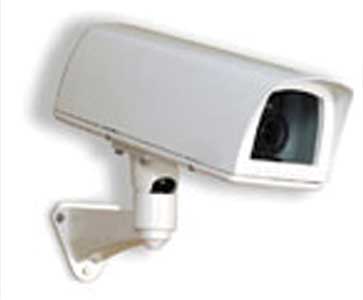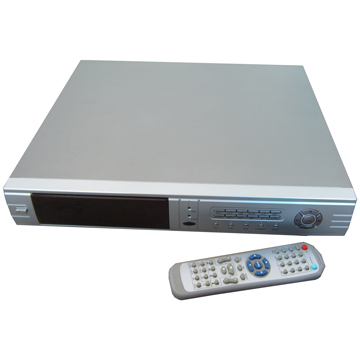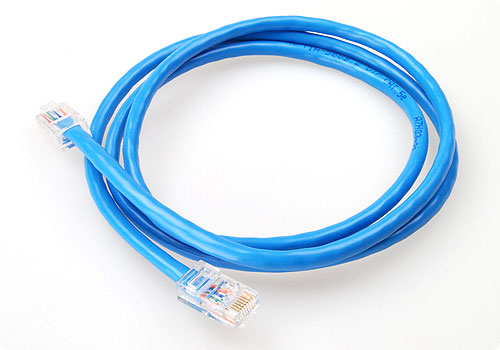| Closed-circuit television |
| Closed-circuit television (CCTV) is the use of video cameras to transmit a signal to a specific place, on a limited set of monitors. |
| It differs from broadcast television in that the signal is not openly transmitted, though it may employ point to point (P2P), point to multipoint, or mesh wireless links. Though almost all video cameras fit this definition, the term is most often applied to those used for surveillance in areas that may need monitoring such as banks, casinos, airports, military installations, and convenience stores. departement stores Videotelephony is seldom called "CCTV" but the use of video in distance education, where it is an important tool.. |
| In industrial plants, CCTV equipment may be used to observe parts of a process from a central control room, for example when the environment is not suitable for humans. CCTV systems may operate continuously or only as required to monitor a particular event. A more advanced form of CCTV, utilizing Digital Video Recorders (DVRs), provides recording for possibly many years, with a variety of quality and performance options and extra features (such as motion-detection and email alerts). More recently, decentralized IP-based CCTV cameras, some equipped with megapixel sensors, support recording directly to network-attached storage devices, or internal flash for completely stand-alone operation. |
| Surveillance of the public using CCTV is particularly common in the United Kingdom, where there are reportedly more cameras per person than in any other country in the world. There and elsewhere, its increasing use has triggered a debate about security versus privacy. |
| Equipment | Function |
|---|---|
 |
CCTV cameras functioning as the image makers |
 |
DVR video recorder |
 |
Monitor to display video |
 |
Cable all cables 75 Ohm, to send image data from camera to dvr |
 |
Radio sending image data remotely |
 |
LAN Cable connect the dvr to the radio |
| CCTV Lens Glossary |
| Below are commonly used CCTV terms that can help you select the right lens for your CCTV application. |
| A.L.C. (Automatic Level Control) - An adjustment on video iris lenses also known as the "average to peak" control. This allows iris compensation for bright spots within the field of view either by exposing for them in particular (peak) or by taking an average across the entire scene. |
| ANGLE OF VIEW - Can be expressed in Diagonal, Horizontal, or Vertical. Smaller focal lengths give a wider angle of view. |
| APERTURE - The "opening" of the lens, the size of which is controlled by the iris and is measured in F numbers. Generally, the lower the F number, the larger the aperture and consequently more light can pass through the lens. |
| MAXIMUM APERTURE - The largest size to which the diaphragm of the lens can be opened. (The lowest f-number) |
| AUTO-IRIS LENS - A lens with an electronically controlled iris allowing the lens to maintain one light level throughout varying light conditions. |
| BACK FOCUS - A term used to describe the relationship of the distance of the lens iris (aperture) to the imager device (CCD chip). This distance is critical to maintain proper depth of field through changing focal lengths and varying lighting conditions. The back focus is achieved by adjusting the imager position or lens collar in the camera itself. It is important when using zoom lenses to ensure that correct focus is maintained throughout the zoom range. This is often referred to as "tracking". |
| BOARD CAMERA - Board Cameras are usually a fixed lens mounted on a circuit board. These cameras are often used in mini cameras, dome cameras and hidden cameras. |
| CCTV - Short for closed circuit television: A video system used in a closed environment (as opposed to public broadcast). The realm of video security and surveillance is also referred to as CCTV. |
| "C"-MOUNT - An industry standard for mounting a lens to a camera, which has a 1 inch diameter, threaded barrel with 32 threads per inch. The sensor is located 0.69 inches behind the mounting surface. A C-mount lens can be used with a CS-mount camera with the use of an adapter ring, however a CS-mount lens cannot be used on a C-mount camera. |
| "CS"-MOUNT - A relatively new industry standard for mounting a lens to a camera. Like the C-mount lens, the CS-mount lens has a 1 inch diameter, threaded barrel with 32 threads per inch. The difference is the CS-mount sensor is located 0.492 inches behind the mounting surface (where as a C-mount sensor is 0.69 inches behind the mounting surface). A CS-mount lens can not be used on a C-mount camera. |
| DEPTH OF FIELD - The areas in front of and behind the focused distance where the image remains in focus. With a greater depth of field, more of the scene near to far is in focus. Lens aperture and scene lighting greatly influences the depth of field. The larger the f-numbers, the greater the depth of field. |
| EXTENSION TUBES - Various sized spacers used between the camera and lens to reduce the Minimum Object Distance. |
| F-NUMBER - Indicates the brightness of the image that is formed by the lens, controlled by the iris. The smaller the F-number, the brighter the image. |
| F-STOP - A term used to indicate the speed of the lens. The smaller the f-number, the greater the amount of light that can pass through the lens. |
| FIELD OF VIEW - The horizontal or vertical scene size at a given length from the camera to the subject. The maximum angle of view that can be seen through the lens. |
| FIXED LENS - A fixed focus lens has one set focal length with a specific field of view which cannot be changed. |
| FOCAL LENGTH - The distance from the center of the lens to a plane at which point a sharp image of an object viewed at an infinite distance from the camera is produced. The focal length determines how much magnification a lens provides. A shorter focal length lens will be able to see a wider angle of view on a scene. A longer focal length has a narrower angle of view on the scene, but a higher level of magnification. |
| FORMAT - The approximate size of a camera image detection device. This term is used to determine the size of lens that can be used on various types of cameras. A 1" format lens will work on a 1", 2/3", 1/2", 1/3", 1/4" (and down) size cameras. A smaller format lens will not work well on a larger format camera. Using a smaller format lens on a larger camera causes distortions ranging from tunnel vision to poor back focus. |
| IRIS - The lens "iris" is a mechanical device for controlling the lens aperture (lens opening). A lens may be fixed, manual controlled and/or voltage controlled. |
| IRIS OVERRIDE - An additional circuit in an Auto Iris lens allowing the operator to switch to full control of the iris, from maximum to minimum aperture. This is particularly useful for difficult lighting situations such as strong backlighting. |
| LINE SCAN LENS - A lens designed for use in scanning lines in documents and design drawings. |
| LUX - The international unit of illumination in which the meter is the unit of length. It is equal to the illumination of a surface one meter away from a single candle. One lux equals one lumen per square meter. 10 lux equals 1 foot-candle. |
| MACHINE VISION LENS - A lens designed for factory automation purposes. The correct choice of lens can reduce image-processing requirements and improve system performance. Software cannot correct the effects of a poorly chosen lens. |
| MANUAL IRIS LENS - A lens with a manual adjustment to set the iris opening (aperture) to a fixed size. This type lens is often used in fixed lighting conditions. |
| MINIMUM OBJECT DISTANCE (M.O.D.) - The closest distance a lens can focus on an object. Generally the smaller the focal length, the shorter the M.O.D. This distance can be altered with use of extension tubes. |
| MONOFOCAL LENS - A lens having only one focal length, and therefore a fixed field of view depending on the format of the camera. |
| PINHOLE LENS - Lenses used primarily in covert applications where the camera/lens must remain hidden. |
| PRESETS - The pre-positioning of the zoom, focus, and/or iris by means of potentiometers built into the lens. |
| UV LENS - A lens intended for use with wavelengths shorter than about 380 nm. It must be made of quartz or some other material transparent to ultraviolet radiation, as glass is opaque in that region. |
| VARIFOCAL LENS - A lens that can be manually adjusted for the desired magnification and field of view. |
| ZOOM LENS - A lens with the ability to change the focal length manually or with a controller, to cover a variety of needs. |
| ZOOM RATIO - The ratio between a lens maximum and minimum focal length, e.g. a 12 to 240mm lens has a zoom ratio of 20 times (240/12 = 20). |
Tidak ada komentar:
Posting Komentar